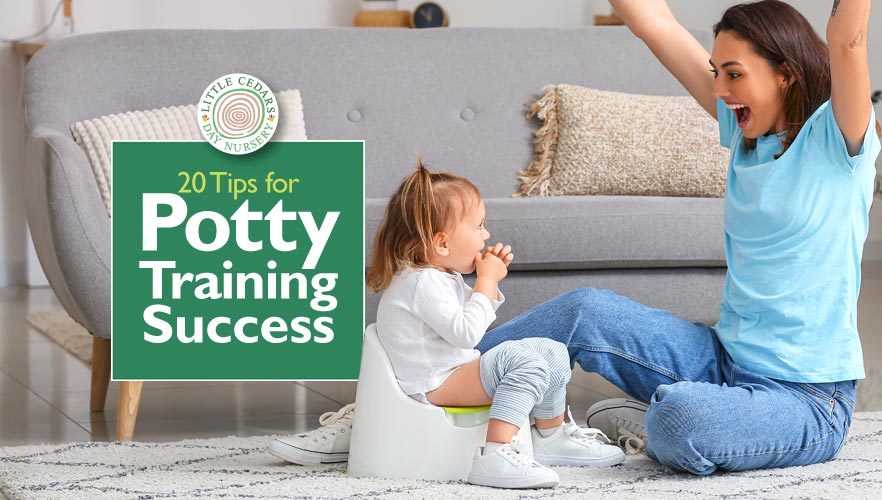
While some toddlers take to it like a duck to water, potty training can be quite daunting for others. It’s a task that can sometimes be the source of considerable upset for little ones which, in turn, can be stressful for parents. However, with the right tools and some useful tips from experts and those who have already gone through the process, potty training can be plain sailing. With that in mind, today’s guide gathers together 20 top tips for successfully fast-tracking potty training — take a look!
Before we begin on the tips, though, let’s see what we should be expecting from our little ones:
When Should We Expect Children to Master Potty Training?
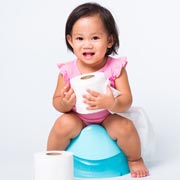 Children are all different. They learn and develop at different rates to each other and that applies to potty training success too. Circumstances in each family are different too, and this will also have an effect. In other words, there is no hard and fast rule about the age by which little ones should have mastered the use of the potty. Parents should therefore not worry if their child is slower to master toileting than their siblings or peers. That said, some very rough guidelines will always be useful to parents and these follow.
Children are all different. They learn and develop at different rates to each other and that applies to potty training success too. Circumstances in each family are different too, and this will also have an effect. In other words, there is no hard and fast rule about the age by which little ones should have mastered the use of the potty. Parents should therefore not worry if their child is slower to master toileting than their siblings or peers. That said, some very rough guidelines will always be useful to parents and these follow.
During the daytime, some tots will manage to stay mostly dry by the age of two to three, with most achieving it completely by the age of four. It’s a huge milestone when it finally happens!
During the night, most are also dry overnight by the age of six, although generally, infants will no longer poop at night even earlier — around the age of 12 months. That said, some children continue to wet the bed at night well beyond the age of 5 or 6. This can be for a variety of reasons, for example, simply because they sleep so deeply. They should never be told off about such incidents and minimal fuss should be made (they are, after all, accidents). The good news is that children are likely to grow out of bed-wetting anyway. We may follow up at a later date to write about measures families can take to minimise the likelihood of bed-wetting incidents for children over five.
20 Top Tips for Potty Training Success
Now we’ve outlined the key background information, it’s time for our 20 tips for potty training success.
- A good time to start your child on potty training is when they have shown that they’re aware of what’s in their nappy. Clues include looking in the nappy during a change, showing discomfort when in need of a change, or showing an awareness that they’re actually going to the loo.
- Beginning potty training during the warmer months of the year is also another top tip. That way, children will be wearing less clothes and what clothes they are wearing will be easier to dry on the washing line.
- Teach little ones all the appropriate words around the topic of potty training and toileting. By empowering them to use such language, they’re much better placed to ask to go to the loo in good time.
- Try rewarding your child for successful use of the potty. The promise of a treat for a successful ‘number two’ can often be all that’s needed to convince a reticent child to attempt it on the potty. Colourful reward stickers and a toileting chart celebrating successes also encourage children.
- When a number one or two are each achieved, especially early on in their potty training, celebrate and congratulate your child — these are huge milestones! Giving them praise will encourage them to build on their success.
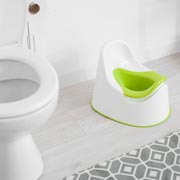 Allowing your toddler to help choose their potty can automatically make it less daunting and instead more of a ‘friendly’ thing to have in their life.
Allowing your toddler to help choose their potty can automatically make it less daunting and instead more of a ‘friendly’ thing to have in their life.- Potties and toileting accessories that feature your child’s favourite characters, for example, dinosaurs, unicorns, or TV characters, will also make them much more friendly and even fun to the little one.
- Indeed, choosing the ‘right’ potty and toileting accessories is important on many levels. There are many different kinds to choose from, each suitable for different circumstances and preferences, including:
Portable potties for when you’re out and about (some even come in a travel case format with wheels). Training seats that attach to an adult toilet. Musical potties that activate a song when they’ve sensed a successful use; these are great for children to sing along to and doing so will encourage them. A set of suitable steps will also help little ones get themselves to the right height once they’ve progressed from a potty to a toilet. These are also useful for reaching adult-level sinks to wash their hands. 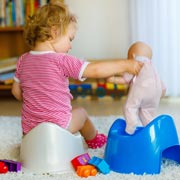 Children can also be encouraged by having their own toy potties. They, and parents, can ‘train’ teddies and dolls to use these during play. Doing so will help them be both relaxed and more educated about potty training — even proactive.
Children can also be encouraged by having their own toy potties. They, and parents, can ‘train’ teddies and dolls to use these during play. Doing so will help them be both relaxed and more educated about potty training — even proactive.- Parents can also source potty training-themed books, stories, songs, YouTube videos and even games that will help children engage in the potty-training process whilst also making it fun.
- When potty training first begins, it’s a great idea to encourage your toddler to visit the potty at initially short, regular intervals. This could be every 30 minutes at the start but can be gradually extended to longer intervals once the child is showing signs of success.
- Ensure your child tries to use the potty immediately before bedtime, of course, and when they wake up from any period of sleep (day or night). It’s also a good idea to encourage them to use it after meals.
- When progressing away from using nappies, the use of ‘pull-ups’ is a good tool for the transition. Pull-ups are midway between a nappy and traditional underwear and, as such, will both protect and get children used to not wearing nappies.
- When starting potty training, picking a quiet time will help children focus, so they do not get distracted or put off.
- Setting a toileting schedule that doesn’t conflict with other items in your child’s routine will also help. Sticking to such a schedule will get little ones used to using the potty — and indeed they’ll expect to do so.
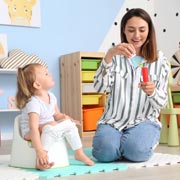 Don’t forget to make potty training fun! Many of these tips will help towards that, including the rewards idea (#4), praise (#5), characters on potties (#7), toileting-themed music (#8), and so on.
Don’t forget to make potty training fun! Many of these tips will help towards that, including the rewards idea (#4), praise (#5), characters on potties (#7), toileting-themed music (#8), and so on.- Normalise the whole process. The last thing potty training needs to be perceived as is a ‘problem’, so making it just a normal part of everyday life is essential to success.
- Let them know that their friends or peers are also potty training (or trained). Ensure children know that you also went through the process of potty training, as did older siblings, friends, and relatives. In this way, they won’t be made to feel ‘different’ or that something is ‘wrong’.
- Keep calm in front of your child even if they begin to get stressed during potty training or toileting. Don’t let them hear anything negative about potty training, including any accidents, which will happen however swimmingly the training goes.
- Remember that part of potty training is also teaching your child good hygiene practices including the need to always wash hands after use of the potty or toilet. They need to understand that this is essential for their health,
 household cleanliness, and for their independence.
household cleanliness, and for their independence.
With successful potty training comes an easier home life for parents, improved cleanliness and hygiene for children and, with no nappies to buy, less household expense. Mastering potties and later the toilet will also be a huge boost to children’s independence and self-confidence; both being hugely important at nursery/preschool and, in particular, when they begin school.
Our Nursery in Streatham, London SW16
Little Cedars Nursery: High-Quality Childcare Services in Streatham


We hope that today’s potty training tips help to make the process go smoothly. We are Little Cedars Nursery in Streatham, London SW16, situated conveniently close to Furzedown, Tooting, Norbury, Balham, and Colliers Wood. As a Good Provider of early years childcare, we give babies, toddlers, and preschoolers under 5 the very best start in life. We bring out the best in them, so they’re ready to hit the ground running by the time they start school. We also support many of the Government’s free childcare schemes to make it more affordable for eligible families.
Contact Little Cedars Nursery today to register your child for a childcare place, ask a question, or book a free tour of the setting:

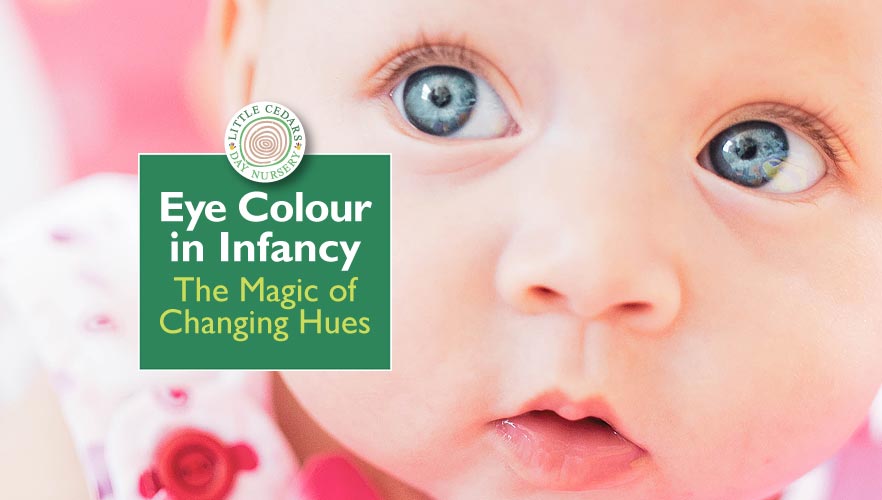
 Have you ever noticed that some babies are born with blue or grey eyes that later change to brown, green or hazel? It’s a magical metamorphosis that sometimes occurs in growing infants and it can be quite intriguing. Parents may indeed wonder whether their newborn child’s eyes are going to change or remain the same as they were at birth. The answer comes down to a combination of time, location, genetics and something called Melanin and today’s article explores this captivating phenomenon.
Have you ever noticed that some babies are born with blue or grey eyes that later change to brown, green or hazel? It’s a magical metamorphosis that sometimes occurs in growing infants and it can be quite intriguing. Parents may indeed wonder whether their newborn child’s eyes are going to change or remain the same as they were at birth. The answer comes down to a combination of time, location, genetics and something called Melanin and today’s article explores this captivating phenomenon.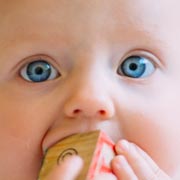 When we talk about eye colour we are, of course, talking primarily about the colour of the irises of a human’s eyes. The iris is the circular muscle around the centre pupil and it is this muscle that governs how much light can pass into the eye by making the pupil larger or smaller. When there is lots of light around, the iris constricts the size of the pupil and, in contrast, makes it big when light levels are low.
When we talk about eye colour we are, of course, talking primarily about the colour of the irises of a human’s eyes. The iris is the circular muscle around the centre pupil and it is this muscle that governs how much light can pass into the eye by making the pupil larger or smaller. When there is lots of light around, the iris constricts the size of the pupil and, in contrast, makes it big when light levels are low. Melanin is a protein that’s secreted by special skin cells called melanocyte cells, which form colouration pigmentation in our bodies, including in the eyes, hair and skin. When it comes to the eyes, a lot of melanin pigment means the eye colour is more likely to be dark, for example brown. In contrast, those without much melanin eye pigmentation will have lighter eyes, for example, grey or blue. It is also those lighter colours that are most affected by the Rayleigh Scattering and Tyndall effects that we discussed in the last section.
Melanin is a protein that’s secreted by special skin cells called melanocyte cells, which form colouration pigmentation in our bodies, including in the eyes, hair and skin. When it comes to the eyes, a lot of melanin pigment means the eye colour is more likely to be dark, for example brown. In contrast, those without much melanin eye pigmentation will have lighter eyes, for example, grey or blue. It is also those lighter colours that are most affected by the Rayleigh Scattering and Tyndall effects that we discussed in the last section.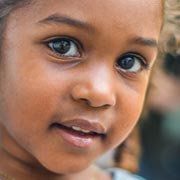 Melanin is a protective protein and, by having more melanin pigmentation, an eye has greater protection against harmful ultraviolet (UV) sun rays. That’s one of the reasons that populations from hot, sunnier countries are more likely to have brown or darker eyes — because those are better protected from the sun’s UV rays. Indeed, brown eyes are the most common eye colour in infancy, despite some common misconceptions. It is true, however, that blue or grey eyes are common in infancy in Northern Europe, where the sunlight is less strong.
Melanin is a protective protein and, by having more melanin pigmentation, an eye has greater protection against harmful ultraviolet (UV) sun rays. That’s one of the reasons that populations from hot, sunnier countries are more likely to have brown or darker eyes — because those are better protected from the sun’s UV rays. Indeed, brown eyes are the most common eye colour in infancy, despite some common misconceptions. It is true, however, that blue or grey eyes are common in infancy in Northern Europe, where the sunlight is less strong.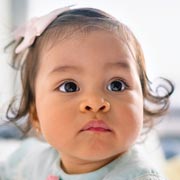 Genetics also play a part in the colour of the eyes and can be helpful when attempting to predict a newborn’s eye colouring. However, correctly predicting the colour of a baby’s eyes based solely on that of parents is not guaranteed. That’s because any inherited colouration may skip one or more generations. And, with a mix of different chromosomes and genes being passed down from parents, grandparents and beyond, skipping generations can sometimes result in completely unexpected eye colouring in infants. Genes will also control how much melanin will initially be present in a newborn’s eyes as well as affecting further production as the child ages and the eyes adjust to conditions.
Genetics also play a part in the colour of the eyes and can be helpful when attempting to predict a newborn’s eye colouring. However, correctly predicting the colour of a baby’s eyes based solely on that of parents is not guaranteed. That’s because any inherited colouration may skip one or more generations. And, with a mix of different chromosomes and genes being passed down from parents, grandparents and beyond, skipping generations can sometimes result in completely unexpected eye colouring in infants. Genes will also control how much melanin will initially be present in a newborn’s eyes as well as affecting further production as the child ages and the eyes adjust to conditions. Heterochromia is a condition that affects less than 1% of the world’s population. Those affected may have two different coloured eyes or perhaps two colours present in one eye. The causes of heterochromia include physical injury, disease, genetics or sometimes the use of specific medications.
Heterochromia is a condition that affects less than 1% of the world’s population. Those affected may have two different coloured eyes or perhaps two colours present in one eye. The causes of heterochromia include physical injury, disease, genetics or sometimes the use of specific medications.